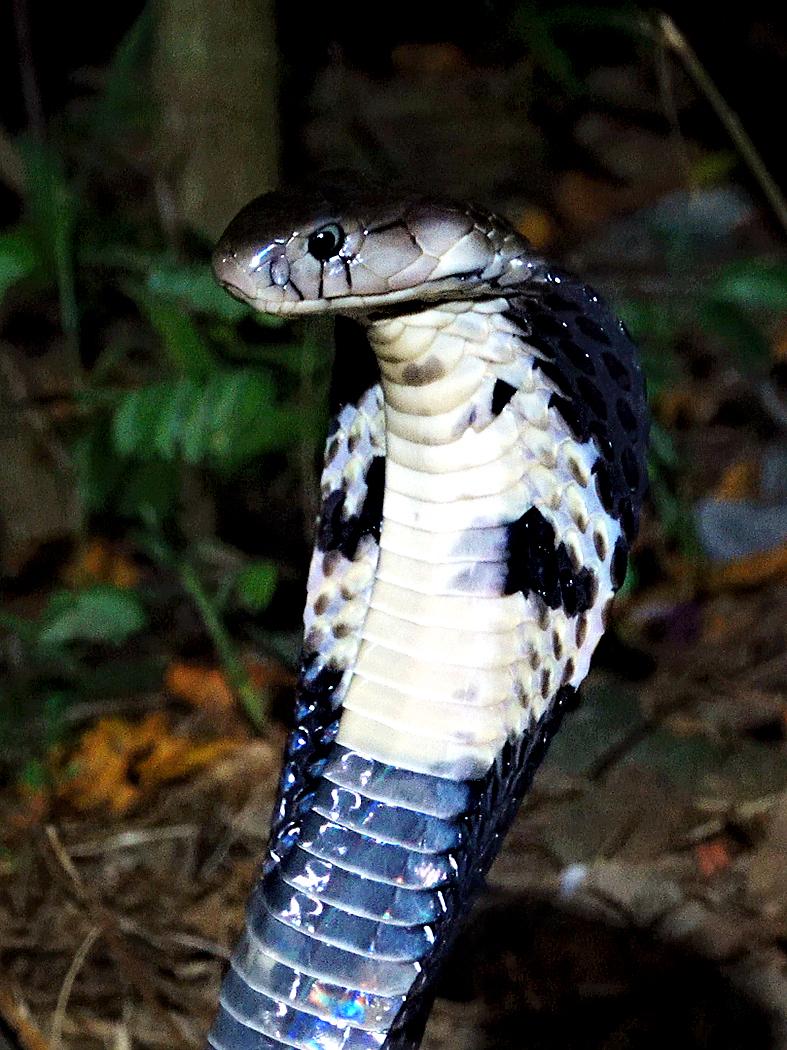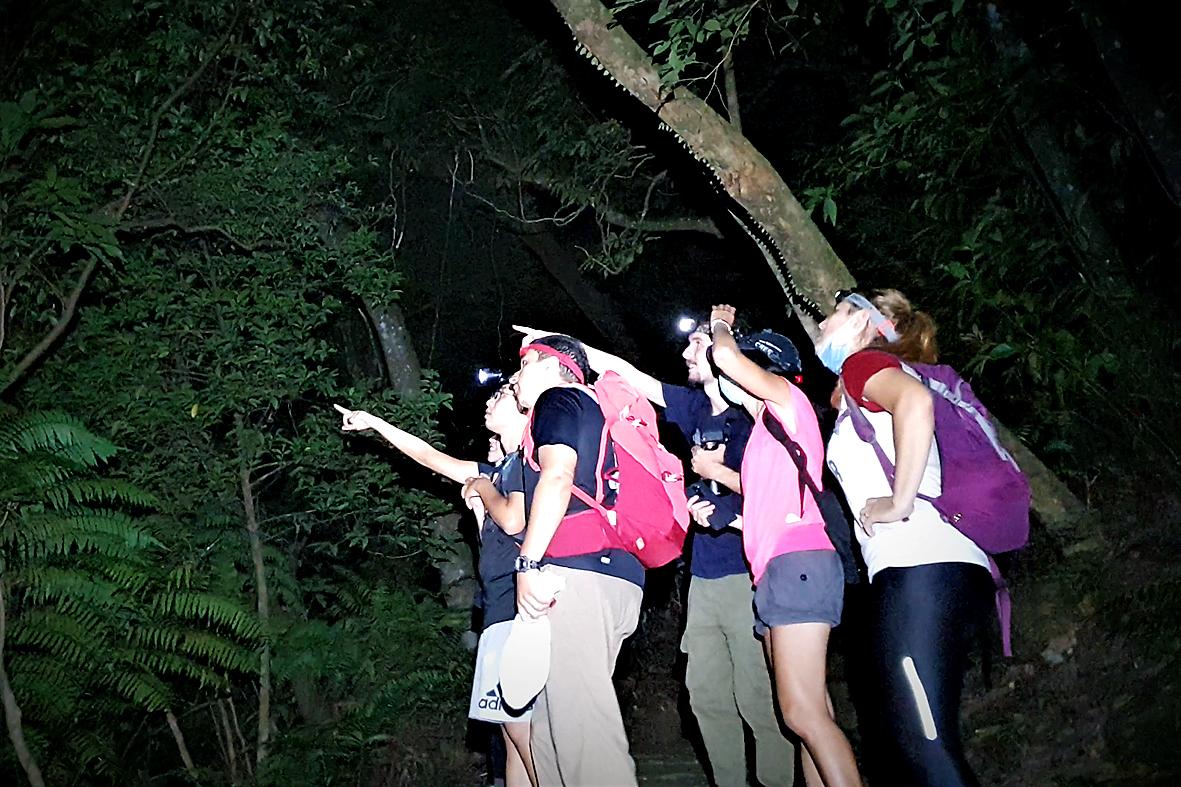As the head of a cobra emerges from the rocks beside the trail, its hood spread in full display, everyone in our party jumps back. It locks its eyes on the nearest photographer, making a steady hissing sound and slowly shaking its head from side to side. With a violent hiss it strikes out at the hands of the approaching cameraman.

Photo: James Osborne
We are on stage five of the seven-stage, 92km Taipei Grand Trail, a collection of preexisting trails that circumnavigate the Taipei Basin. The 13km Jiantan Branch Trail (劍潭支線) starts at Bishan Temple (碧山巖開漳聖王廟) in Neihu (內湖) and runs along the ridge, then finally ends next to Jiantan MRT station (劍潭站).
Rather than take the bus to the trail head, we walk up from Dahu Park MRT (大湖公園站) via Dagouxi Waterfront Park (大溝溪生態治水園區). We are glad to have made that decision as we stumbled upon our first snake of the night, a Taiwan cobra (Naja atra).
SNAKES, SNAKES, EVERYWHERE

Photo: James Osborne
The front third of its body raised up and its hood spread, the cobra would not back down. With all its hissing and dry-striking at the air before us, we maintain a safe distance. Despite its threatening display and fierce reputation, our group of 12 trekkers are more curious than afraid, thrilled to have such a rare encounter with one of Taiwan’s deadliest snakes.
As we leave, the cobra lowers its hood and slithers away into the trees. A few steps on and we encounter another snake. Illuminated by our flashlights, the shape of a meter long snake slithers across the path right among their legs.
This time it’s just a red-banded snake (Lycodon rufozonatus); a bit confused by the lights. It quickly leaves the trail as everyone is reassured to know it’s non-venomous.

Photo: James Osborne
From Bishan Temple we take in the panoramic views of Taipei as we check our watches and realize it is almost 10pm. This is the official start of the fifth stage, so we begin to worry that we may be in for a really late night.
As we pick up the pace we nearly miss a tiny baby mock viper (Psammodynastes pulverulentus) immobile on a branch next to the path. Further on, we see a non-venomous greater green snake (Ptyas major) sleeping on a shrub. Shortly after, a Taiwanese tree snake (Boiga kraepelini) gracefully glides through the branches of a tree over-head.
In our haste, someone bumps into a green snake on a trail-side branch. Startled, the snake leaps off its perch as we all step back. Not to fear, I explain to the group, unlike green tree vipers (Trimeresurus stejnegeri ), greater green snakes are not venomous.

Photo: James Osborne
Soon another deadly snake is in our midst. Moving down the trail toward us, a highly-venomous Taiwanese krait (Bungarus multicinctus).
Everyone breathes a sigh of relief as the snake makes a 90 degree turn and disappears into the undergrowth. Happy with their photos, the group agrees that I should take the lead for fear of what we might encounter next.
Minutes later we emerge atop a small peak with more panoramic views, including the Miramar Ferris Wheel (美麗華百樂園摩天輪) all lit up far below.

Photo: James Osborne
MOTORCYCLE BREAKS SILENCE
Steep steps lead us down as we pass a lonely turtle making its way through the dark forest. The ferns are adorned with sleeping butterflies, and of course more greater green snakes.
All at once the tranquility of the forest is shattered, as out of nowhere the roar of a motorcycle comes hurtling toward us. We are just able to register what’s going on and all scurry to the side of the path right as a dirt-bike comes flying down the trail. It turns out there are greater dangers than snakes on these trails.

Photo: James Osborne
More greater green snakes, a red-banded snake eating a toad and more fantastic views greet us as we continue on toward Jiantan. The trail is easy to walk and our pace is good.
As we descend from Old Place Lookout (老地方觀景平台), a collared scops owl (Otus lettia) swoops over-head and lands in a tree in front of us. Seeing that we were not mice, it turns and flies off back into the dark forest.
We are still full of beans when we arrive at the end of the trail near Jiantan MRT Station, and realize it is only 2am. We had completed the 5th stage in only 4 hours. Only six hours including the slow walk up through Dagouxi Park. We are getting good at this.

Photo: James Osborne
James Osborne has been living in Taiwan for about two years, where he has been pursuing a passionate hobby of discovering and filming Taiwan’s unique biodiversity. Check out his Youtube channel (James Osborne) for videos on his ecological adventures.

The slashing of the government’s proposed budget by the two China-aligned parties in the legislature, the Chinese Nationalist Party (KMT) and Taiwan People’s Party (TPP), has apparently resulted in blowback from the US. On the recent junket to US President Donald Trump’s inauguration, KMT legislators reported that they were confronted by US officials and congressmen angered at the cuts to the defense budget. The United Daily News (UDN), the longtime KMT party paper, now KMT-aligned media, responded to US anger by blaming the foreign media. Its regular column, the Cold Eye Collection (冷眼集), attacked the international media last month in

On a misty evening in August 1990, two men hiking on the moors surrounding Calvine, a pretty hamlet in Perth and Kinross, claimed to have seen a giant diamond-shaped aircraft flying above them. It apparently had no clear means of propulsion and left no smoke plume; it was silent and static, as if frozen in time. Terrified, they hit the ground and scrambled for cover behind a tree. Then a Harrier fighter jet roared into view, circling the diamond as if sizing it up for a scuffle. One of the men snapped a series of photographs just before the bizarre

Power struggles are never pretty. Fortunately, Taiwan is a democracy so there is no blood in the streets, but there are volunteers collecting signatures to recall nearly half of the legislature. With the exceptions of the “September Strife” in 2013 and the Sunflower movement occupation of the Legislative Yuan and the aftermath in 2014, for 16 years the legislative and executive branches of government were relatively at peace because the ruling party also controlled the legislature. Now they are at war. The Democratic Progressive Party (DPP) holds the presidency and the Executive Yuan and the pan-blue coalition led by the

For decades, Taiwan Railway trains were built and serviced at the Taipei Railway Workshop, originally built on a flat piece of land far from the city center. As the city grew up around it, however, space became limited, flooding became more commonplace and the noise and air pollution from the workshop started to affect more and more people. Between 2011 and 2013, the workshop was moved to Taoyuan and the Taipei location was retired. Work on preserving this cultural asset began immediately and we now have a unique opportunity to see the birth of a museum. The Preparatory Office of National